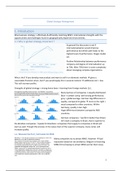Global Strategic Management
1. Introduction
Mno business strategy = effectively & efficiently matching MNE’s international strengths with the
opportunities and challenges found in geographically dispersed environments.
1.1 Why is global strategy important ?
In general the discussion is not if
internationalization would improve
performance but which path leads to the
highest level of performance. Stages model
ect.
Positive Relationship between performance
company and degree of internalisation up
to 70%. After 70% there is some complexity
about managing complex organisations.
Why is this? If you develop new product and want to sell it on domestic markets → gives u
reasonable financial return, but if you would apply this in several markets → additional cost = low.
This will increase profits.
Strengths of global strategy = strong home base + learning from foreign markets (↓).
Best practices of companies ≠ equally distributed.
Blue = number comp. with strong performance,
grey = global average. German: Big differences in
quality, compared to globe → more to the right =
excel compared to other countries. Within
Germany, quality is less high.
Huge differences between companies AND
countries.
German companies: ‘I perform better than Brazil,
let’s start a company in Brazil, that is superior to
the Brazilian companies.’ Upside for Brazilians: companies that supply to companies in Brazil will
learn as well. Though this process in the value chain of the superior company, many comp. will
increase quality.
E . G. WASHINGTON POST, S EPTEMBER 16 2019.
Many companies try to attract MNO. However → bad
reputation based on tax avoidance. Belgium is favouring
MNO-firms (hoping to attract MNO and let them stay).
1
,1.2 Spillover effects of multinational investment
• Multinationals have access to knowledge across the globe, which the can combine in superior
products and services. This influx of knowledge is relevant for innovation and productivity
improvements of the whole country, particularly when local companies have high absorptive
capacity.
• However, the size of these positive spillovers can depend on the allocation decisions of
multinationals in the global value chain.
1.2.1 FSA/CSA Framework
(1) = Comparative-advantage-based trade. The
trade is based on cost advantages that are related
to the location. They are not necessarily linked to a
particular company. If a company has no access to
the country-specific adv. It is difficult to translate
them in a competitive strategic advantage. E.g. low
labor cost in China. PROBLEM: other companies
can also set up a business in China and benefit the
low labor cost. Which results in equal price
reductions → in competitive markets advantages
disappear. It does not necessarily translate in strategic advantages. (2) There would be little reason
for international trade when both advantages are weak. They best stay on the home market.
(3) Challenge of successful MNO.
(4) Trade is based on what is specific about a product. E.g. Car industry: if you buy a Toyota in
Germany, you buy it because of the car’s features, not because of the cost advantages that would
make it more attractive to buy. = differentiation trade, REVERSED. >< comparative trade = always
from 1 location to the other, NOT REVERSED. Japan may sell cars to Europe, but in Japan they also
buy German cars.
1.2.2 Refined FSA/CSA Framework
Still country & firm-specific adv
BUT with home, foreign, global
on the horizontal axis.
Not rely directly to a particular
location, but are developed by
combining the knowledge &
know-how of different
locations into a single project.
E.G. GEELY CHINA: advantage =
country specific low wages →
it is location-bound. But they bought the Volvo-group, this is a foreign country competitive
advantage. And Volvo is known for its firm-specific advantage. Geely combines 2 different profiles in
its global strategy ! they are experimenting with combining them so that engineers can combine
country AND firm-specific advantages. NIKE: has firm-specific advantages in home-country, but has
volume-producers in several foreign countries. E.G. FLEXTRONICS, does not care where it produces, as
long as there is a strong country-specific advantage. Production system is organized centrally in a
global production network. NISSAN R&D is not only for European market, also Japanese&American.
2
, 1.3 Static versus Dynamic strategy
Five forces vs ecosystem framework
Left: supplier power = source of competitive
positioning. If your supplier has a lot of power
→ you will earn less. E.G. PHARMACEUTICAL PRICES
@UK: You only have 1 buyer → gives him a lot
of power.
Gives understanding of current strategic
strength. E.G. APPLE → strong 5-forces
framework.
Question: is strengthen level caused by smart
positioning on the market, or more bec of the innovative capacity, knowledge,… ?
Right: Eco-system analysis allows to assess strength of innovative capacity/dynamic capability. You
can SENSE changes in the market bec of knowledge, you can SHAPE market bec of technology that no
one else has, you SEIZE opportunities bec you have pro-active entrepreneurial decision making.
Globally right model much more important !! key advantage of global firm = dynamic capability,
more than the power and the market positioning.
1.4 Location advantages
• = First mover advantage theory
o Location advantages are not born into a location, they develop in time/particular
moment in time. Through specialization and learning they can build up advantages that
are difficult to imitate by other locations.
• Specialization increases output rather than decreases output and the ability to enhance
economies of scale increases
• Learning effects are high.
o Increasing economies of scale
o These are cost savings that come from “learning by doing”
• Implications for location advantage
o First mover advantage is an important location advantage as scale and experience
effects of first movers may deter new entrants from local markets.
o If a company starts to learn, it obtains an advantage that another company can no longer
catch up with
E.G.: COMMERCIAL AEROSPACE INDUSTRY
• Why are there only 2 dominant firms?
o Airliner development costs about 5 billion euro
o Average unit costs drop 80% each time output is doubled
o Global demand will be about 1500 aircrafts at an average price of 250 million
• IQ 3) Would you advise Mitshubishi Heavy Industries to become a player in the industry?
o 1,2,4,8,16,32,64,128,256, 512
o 5 billion x (0.8)10 =
o 537 million
o Price = +/- 250 million
o → NO, costs are too high to become competitive.
• Boeing did not have their monopoly bec. of the excellent capabilities → but bec. they entered
the market on the right time. Now it is almost impossible to enter the market.
3





